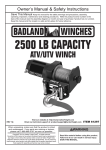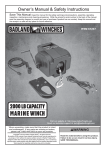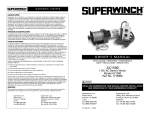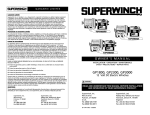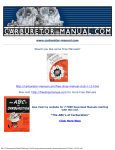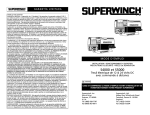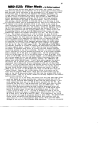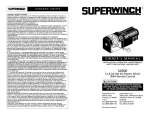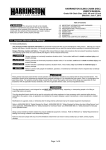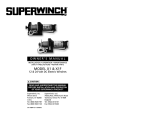Download Superwinch 12 & 24 Volt DC Electric Winch 3000 User's Manual
Transcript
Model 03001 Model 03000 Model 03003 Models 03002 03005 03010 OWNER’S MANUAL INSTALLATION • OPERATION • MAINTENANCE SAFETY PRECAUTIONS • REPAIR PARTS C-SERIES 12 & 24 Volt DC Electric Winch Models 03000, 03001, 03002, 03003, 03005, 03010 READ AND UNDERSTAND THIS MANUAL BEFORE INSTALLATION AND OPERATION OF YOUR SUPERWINCH PRODUCT. Superwinch, Inc. Winch Drive Putnam, CT 06260 U.S.A. Tel. (860) 928-7787 Fax (860) 963-0811 89-12042 Rev E 9/16/02 Superwinch, Ltd. Abbey Rise, Whitchurch Road Tavistock, Devon PL 19 9DR England Tel. +44 (0) 1822 614101 Fax +44 (0) 1822 615204 Working Load* . 1,000 lbs (454 kg) 1 1 1 1 1 1 1 1 1 1 1 1 1 1 1 1 1 1 1 1 1 1 1 5 1 1 5 1 1 5 1 1 5 1 1 5 1 5 1 1 2 ea. 4 ea. 1 2 ea. 4 ea. 2 ea. 4 ea. 2 ea. 4 ea. 1 1 Safety Factor . . . . . . . . . . . . . . 5:1 Description Cable ties Owner’s Manual Remote control switch Without control switch Circuit breaker assembly Pulley block assembly Handsaver Internal solenoids External solenoids 12 Volt Motor 24 Volt Motor (*) Based on first layer performance. This equipment must be used as recommended by the manufacturer. Failure to follow these recommendations could endanger your life and/or cause property damage. 2 2 ea. 4 ea. Braking - A wrap spring brake will support the load when power to the motor stops. 2 ea. 4 ea. Gear Ratio . . . . . . . . . . . . . . . 159:1 Remote Switch - 12’ (3.66m) Hand held pendant switch assembly with interlocking reverse switch and trigger. Winch assembly with roller fairlead (no wire rope) Winch assembly with roller fairlead (with wire rope) Bolts, nuts, lockwashers Flat washers Electric Motor - 1.3 peak hp (0.9 kW) 12 Volt Permanent Magnet. 1 S P E C I F I C AT I O N S 03000 03001 Please unpack carefully and read the instructions before beginning. Inspect carefully for any damage that may have occurred during transit. Check for loose, missing or damaged parts. 1 U N PA C K I N G 03005 For additional information, consult Specifications and Performance. Quantity 03002 03003 The C1000 electric winch is for intermittent duty only. Motor cool-down time is required. Can be mounted horizontally or vertically. Winch can be utilized in a variety of lifting operations involving machinery, trucks, boats, farm implements, etc. Equipped with DC motor, permanently lubricated/sealed gear box, switch with harness assembly, handsaver, and pulley block. 03010 DESCRIPTION 3 PERFORMANCE Load lbs. 0 1000 Speed ft/min m/min kg MODEL 03001 Current Draw* (amps) 12V 24V 0 19.5 5.9 30 15 454 14.7 4.5 80 40 6.0 (152) (*) Based on first layer performance. MODELS 03002, 03005, 03010 DIMENSIONS 13.6 (346) 1.25 (31.8) 6.0 (152) 5.9 (149) 3.69 (93.7) 15.1 (383) 7.1 (179) 1.24 (31.5) 3.69 (93.7 7.2 (183) 5.9 (150) MODEL 03003 3.1 (79) 7.1 (180) 6.0 (152) MODEL 03000 13.6 (346) 6.0 (152) 1.25 (31.8) 15.1 (383) 5.9 (149) 3.69 (93.7) 1.25 (31.8) 5.9 (149) 3.69 (93.7) 7.1 (179) 7.1 (179) NOTES: 1. All dimensions are in inches (millimeters). 2. Typical mount is to flat surface capable of handling the loads. Bolts to be Grade 5 or better. 4 7.1 (179) 5 GENERAL SAFETY I N F O R M AT I O N 9. KEEP THE ELECTRIC CABLES FROM HEAT, OIL, AND SHARP EDGES. Periodically inspect for damage. Do not use for lifting, supporting, or transporting people, or over areas where people are present. Disconnect power before servicing. 10. DO NOT OPERATE THE WINCH WHEN TIRED OR UNDER THE INFLUENCE OF DRUGS, ALC0HOL, OR MEDICATION. 1. READ AND SAVE ALL INSTRUCTIONS. 2. DO NOT OVERLOAD. See Performance information. Do not maintain power to the winch if the motor stalls. Overloads can damage the winch and create unsafe operating conditions. 3. LEARN TO USE WINCH. After installing your winch, take the time to practice using it so that you are comfortable with it when the need arises. Periodically check the winch installation to assure that all bolts are tight. 4. NEVER ALLOW CHILDREN OR UNTRAINED PERSONNEL TO OPERATE WINCH. 5. INSPECT ELECTRIC CABLE FITTINGS FOR TIGHTNESS BEFORE EACH USE. 6. REPLACE DAMAGED OR BROKEN PARTS IMMEDIATELY WITH MANUFACTURER’S RECOMMENDED REPLACEMENT PARTS. Never connect winch to 110VAC power as fatal shock may occur. 7. USE CAUTION WHEN using the winch. KEEP PEOPLE, PETS, AND PROPERTY CLEAR OF THE PATH OF THE LOAD. DO NOT USE WINCH TO LIFT OR MOVE PEOPLE. 8. DO NOT USE THE WINCH TO SUPPORT AN UNATTENDED LOAD. 6 11. NEVER INSTALL WINCH IN SUCH A WAY THAT THE WARNING AND INSTRUCTION LABELS ARE OBSCURED. Someone who has not read this manual may need to see them to understand the proper operation of the winch. 12. Always operate the winch with an unobstructed view of the winching operation. 13. CHECK FOR CORRECT DIRECTION OF ROTATION BEFORE USING WINCH. The winch must be properly wired to ensure correct direction of drum rotation. 14. REMOVE AND STORE THE REMOTE PENDANT ASSEMBLY IN A SAFE PLACE when not in use to prevent unauthorized use. 15. ALWAYS UNPLUG THE REMOTE PENDANT BEFORE WORKING IN OR AROUND THE ROLLER FAIRLEAD OR WINCH DRUM (THE DANGER ZONE) to prevent the winch from being turned on accidentally. Use handsaver when winding end of wire rope. 16. When lifting a load, slowly take up the slack until it becomes taut. Stop, recheck all winching connections. LOCATION Mount the winch to a firm base. The structure the winch is attached to must be capable of withstanding a load greater than 1-1/2 times the winch’s rated line pull. When attaching wire to the motor terminals and solenoids (relays), hold the inner nut when tightening the outer nut. Do not allow the terminals to rotate. It may cause internal wire breakage or part misalignment. Be especially careful in preventing the solenoid (relay) terminals from rotating. Any rotation can damage the solenoid (See Figure 1). The winch can be mounted in a horizontal or vertical position. Do not mount the winch where there would be the possibility of it being submerged in water. The winch is weather resistant but not waterproof. This winch MUST be mounted with the pull in the underwind direction. Improper mounting could damage your winch, cause the brake to not work and void your warranty. Step (1) Install structural support for winch. See "Dimensions" section for winch dimensions. Figure 1 Step (3) Disconnect the battery leads. Step (2) Mount the winch to the mount that you have designed. Batteries contain gases which are flammable and explosive. Wear eye protection during installation and remove all metal jewelry. Do not lean over battery while making connections. Mounting bolts supplied are the correct length for use with a 1/4" (6.3mm) thick mounting plate. Step (4) Model 03003 Select a convenient location for mounting the Solenoid Remote Control Assembly. The solenoid Electrical Schematic REVERSAL SWITCH (Switch may be in Either Position) Green 17. DO NOT MACHINE OR WELD ANY PART OF THE WINCH. Such alterations may weaken the structural integrity of the winch, and void your warranty. 18. Never allow shock loads to be applied to winch. Do not substitute any bolt with strength weaker than grade 5. I N S TA L L AT I O N 4 Black 3 REVERSAL SWITCH (Rope-In position) Green 4 1 Green 4 Load Line White NC Trigger Switch NC Winch Motor OFF Load Line White NC Black 3 1 1 Load Figure 2 Black 3 REVERSAL SWITCH (Rope-Out position) Trigger Switch NC Winch Motor WIRE ROPE IN Line White NC Trigger Switch NC Winch Motor 7 WIRE ROPE OUT 7 mounting plate must be electrically grounded to the battery. If it is not, the winch will not work. Preferably, the solenoids should be mounted vertically, with the solenoid end terminals pointing downwards. Electrical Connection Cut two lengths of wire, one red and one black, to reach from the winch to the solenoids. When routing all wires, be sure to keep them away from all hot or moving parts. Crimp a 1/4" ring terminal on the end of each wire at the winch end. Attach one wire to each motor terminal (See figure 3). Crimp a 5/16" ring terminal at the solenoid ends of the wires and attach to the terminals on the solenoid assembly as shown in Figure 3. ends of the black wire. Connect one end to the solenoid assembly, and the other end to the battery negative terminal (See Figure 3). Connect the circuit breaker assembly bracket to the battery positive terminal. Plug in the remote control, and with the directional lever in the “Rope Out” position, momentarily depress the trigger to check for proper rotation direction of the winch drum. If the winch runs in the wrong direction, reverse the wires connected to the winch motor. Step (4) Models 03000, 03001 These winches are supplied without controls. To design the control system for your application, you can purchase the needed materials to complete your system from Superwinch, or buy them locally. Superwinch offers an external solenoid pack as shown with Model 03003. (Superwinch Part Number 1515A Remote Control). It comes with 12 foot pendant, 20 feet of 8 gauge wire, and instructions. Circuit Breaker We recommend using a 40 Amp Circuit Breaker between the battery positive terminal and the wire that goes to the switch or solenoid pack (See Figure 5). This can be purchased from Superwinch as Part Number 89-32341. The circuit breaker prevents overloads to the switch and to the winch motor. Hookup Wire If the total length of wire required is less than 20 feet, use 8 gauge wire. If the total length of wire required exceeds 20 feet, use 6 gauge wire. Figure 3 Cut and strip two lengths of wire, one red and one black, to reach from the solenoids to the battery. On the battery end of the red wire, install a 3/16 ring terminal, and attach to the circuit breaker. The other end of the circuit breaker attaches to the harness. On the opposite end of this wire, connect a 5/16 ring terminal and attach to the solenoid assembly (See Figure 3). Install 5/16 ring terminals to both 8 Superwinch offers a (3) Position Heavy Duty Rotary Switch Part Number 1591. The Superwinch switch has an internal shunt that provides dynamic braking to further assist the winch's brake. (See Figure 4) Solenoids You will need (2) 12 Volt double pole, double through solenoids, with a continuous current rating of 80 amps on the normally open contacts and 60 amps on the normally closed contacts. Attach the circuit breaker directly to the battery positive terminal, and reattach the terminal to the battery. Connect the remaining wire to the battery negative terminal, and connect the terminal to the battery. (See Figure 5) Remote Switch Receptacle Motor Green Black You will need a switch or a solenoid control, a circuit breaker, hook up wire, and wire terminals. Switch Select a (3) position reversing switch with a switch action of “momentary on”/“off”/“momentary on”. “Momentary on” means the switch automatically returns to OFF position when released. Minimum contact rating must be 50 amp DC carry. Note: If you choose to locate the winch at a greater distance than the wires provided will permit, it may be necessary to purchase a larger gauge wire to get the best performance from your winch. If the total length of additional wire to be added to the system exceeds 10 ft. (3m), use a larger wire gauge size. White Solenoid Assembly Circuit Breaker Blue Terminated Figure 5 Figure 4 Step (4) Models 03002, 03005, 03010 Route the (2) wires to the battery. To ensure against insulation abrasion and/or cutting, apply several layers of electrical tape where wiring may come in contact with sharp metal parts. Attach the circuit breaker assembly to the end of the blue terminated wire. Wrap the circuit breaker assembly with electrical tape to prevent accidental short circuits. Black + Step (5) Pull the trigger momentarily to check wire rope drum rotation and direction. If the drum rotates in the wrong direction, recheck your wiring. The hand-held pendant switch activates a solenoid that activates power to the winch motor. One solenoid is for power-in (lifting a load) motor direction and the other is for power-out (lowering a load) motor direction (See Figure 6). 9 POWER OUT POWER IN B A Figure 6 PENDANT OPERATION The switch trigger returns to the “OFF” position when released (See Figure 6, Ref. A). The slide button on the back of the switch determines the direction of the drum rotation for lowering or lifting a load (See Figure 6, Ref. B). The slide is fitted with an interlock so that the motor cannot be reversed if the trigger is depressed. To change direction, release the trigger, move the slide button, and depress the trigger again. The switch assembly must be kept free of dirt and moisture to ensure safe operation. To connect the pendant control, lift the dust cover on the plug receptacle (See Figure 7), and insert the plug end of the remote switch. The plug on the pendant control cord is keyed and will fit into the socket only one way. the motor will get hot. Allow to cool after 2 minutes of “ON” time. MAINTENANCE AND REPAIR Periodically check tightness of mounting bolts and electrical connections. Remove any dirt or corrosion that may have accumulated on the electrical connections. BRAKE OPERATION Your winch has a wrap spring brake that stops and holds loads up to 1,000 lb. (454 kg). When the winch is powered out, as in releasing a load, the brake is engaged and the motor must overpower the brake resistance to rotate the drum. Therefore, it is normal for the winch to operate faster in one direction than the other. The brake is designed for the wire rope to be used in the underwind position only. Drum must turn counterclockwise, looking from motor end, when winching in. DO NOT OVERWIND. Powering against the brake will cause heat to build up in the drum and may transfer heat to the wire rope. DO NOT POWER OUT FOR MORE THAN 2 MINUTES. The drum may get very hot. O P E R AT I O N DUST COVER Figure 7 Do not allow winch motor to overheat. The winch is for intermittent use only. During long or heavy pulls 10 WIRE ROPE For safety reasons, it is important that you use a wire rope with a break strength of at least 5,600 lbs. Recommended wire rope for this winch will have a 1/4" diameter with a 7 x 19 construction, and a minimum break strength of 7,000 lbs. or a 7/32" diameter with 7 x 19 construction, with a minimum break strength of 5,600 lbs. REPLACING THE WIRE ROPE Replace damaged wire rope with the manufacturer’s recommended replacement part or a factory approved equivalent identical in strength, quality, lay, and stranding. Pass the attaching end of wire rope through the fairlead and attach it to the drum. When inserting the wire rope into the drum, insert it into the correct end of the hole provided (See Figure 8). Tighten the set screw securely. Keep clear of winch wire rope and hook when operating winch. Never put your finger through thehook. Placing finger(s) in hook could result in injury. 2. Never hook wire rope back onto itself. Hooking wire rope onto itself can damage rope. Use a nylon sling (See Figure 10). When using a sling, make sure that sling is properly seated in saddle of hook. It is important that the wire rope be wound tightly onto the drum. Right Wrong Figure 10 Figure 8 HANDLING THE WIRE ROPE Use heavy leather gloves when handling wire rope. Do not allow wire rope to slide through hands. 1. Never winch with less than 5 turns of wire rope around winch drum, since wire rope and fastener may not withstand the load. ALWAYS USE HANDSAVER BAR WHEN GUIDING HOOK FOR THE LAST FEW FEET OF ROPE (See Figure 9) Figure 9 Avoid continuous pulls from extreme angles. This will cause wire rope to pile up at one end of drum. This can jam wire rope in winch causing damage to rope or winch itself. 3. Do not use wire rope as a ground for welding. 4. Never touch welding electrode to wire rope. 5. Keep wire rope tight and even on drum. 6. Replace wire rope when frayed. TIPS FOR EXTENDING THE LIFE OF YOUR WINCH 1. Keep a tightly wound wire rope drum. Do not allow the wire rope to become loosely wound. A loosely-wound drum allows a wire rope under load to work its way down into the layers of wire rope on the drum. When this happens, the wire rope may become wedged within the body of the windings, damaging the 11 wire rope. To prevent this problem, keep the wire rope tightly and evenly wound on the drum at all times. A good practice is to rewind the wire rope under tension after each use. One way to do this is to attach the hook to a small load and winch that load to rewind rope. 2. To maximize winch and wire rope life, use pulley block to double line heavier loads. LUBRICATION The winch is permanently lubricated. There may be grease leakage out of winch, especially during first few operations. This is normal and it is not necessary to grease or oil any internal part of winch at any time. TROUBLESHOOTING CHART Symptom Possible Cause(s) Motor will not operate or runs in one direction only 1. Damaged or stuck solenoid Periodically lightly lubricate wire rope with penetration oil and wipe off excess. 2. Switch inoperative 2. Replace switch. 3. Broken wires or bad connection 3. Check for poor connections. CAUTION Always use 2 wrenches (See Figure 1). 4. Damaged motor 4 Replace or repair motor. 5. Solenoids not grounded 5. Check the ground path between battery negative and solenoid base. Winch will not shut off Solenoid stuck “ON” If a solenoid sticks on, reverse direction and hold trigger switch until the power lead can be disconnected. A safety disconnect switch is available as an accessory. Motor runs extremely hot 1. Long period of operation 1. Allow to cool. 2. Damaged motor 2. Replace or repair motor. 3. Damaged brake 3. Replace or repair brake. 1. Weak battery 1. Recharge or replace battery. Check charging system. a b c Figure 11 Motor runs but with insufficient power or line speed 2. Battery to winch wire extended with same size wire 3. Poor battery connection Winch runs backward Will not hold load 12 CAUTION Be prepared to disconnect power when performing this test. If a solenoid sticks once, it is likely to stick again and must be replaced immediately. 1. Tap solenoid to free stuck contacts. Check by applying voltage to the small solenoid terminal. Be sure solenoid is grounded back to source. A solenoid that is not stuck will make an audible “click” when first energized. 3. PREVENT KINKS BEFORE THEY OCCUR. (See Figure 11.) a. This is the start of a kink. At this time, the wire rope should be straightened. b. The wire rope was pulled and the loop has tightened to a kink. The wire rope is now permanently damaged and must be replaced. c. Kinking causes the wire strands under the greatest tension to break and thus reduces the load capacity of the wire rope. The wire rope must be replaced. Corrective Action 2. Use larger diameter wire. 3. Check battery terminals for corrosion. Clean as required. 4. Poor ground 4. Check and clean connections. 5. Damaged brake 5. Repair or replace brake. 1. Motor wires reversed 1. Recheck wiring. 2. Solenoids wired incorrectly 2. Recheck wiring. 1. Excessive load 1. Reduce load or double line. 2. Worn or damaged brake 2. Repair or replace brake. 13 REPLACEMENT PA R T S REPLACEMENT PA R T S L I S T Reference Number 31 28 26 20 21 22 23 24 25 26 27 28 29 30 31 29 10 11 25 12 30 13 27 37 11 14 15 34 16 17 33 2 37 18 Sa fe ty 65 37 & 32 38 34 36 33 19 1 2 3 4 5 6 7 8 9 10 11 12 13 14 15 16 17 18 19 26 20 8 1 2 23 22 3 4 5 21 6 24 7 9 29 32 14 33 34 36 37 38 NS NS NS NS NS NS NS NS (NS) Description Part Number Base 89-52021 Groove pin 89-23303-01 Cable guard 89-32268 Main bearing 89-22268 Drum 89-40152 M6 x 1 x 8mm Set PT screw 90-23164-12 Brake spring 89-22342 Brake adapter 89-22287 Drum bearing 89-22269 Drum support 89-40092 Thrust washer 90-12574 Drive plate 89-32263 Rotating ring gear 89-32265 Planetary carrier assembly 89-22141 Wear washer 89-22271 Sun gear 89-32253 Stationary Ring Gear 89-32266 Housing Assembly 89-40157 12V Motor (03000, 03001, 03002, 03003, 03005) 90-33256 24V Motor (03010) 89-32386 Cable Tension Plate 89-32295 M6 x 1 x 16mm FCHSS Screw 89-22291-01 Roller Fairlead Shaft (Includes 22-27) Roller Fairlead Shaft (Long) 89-22334-02 Roller Fairlead Frame 89-40113 Roller Fairlead Shaft (Short) 89-22334-01 3/8 Retaining Ring 90-23029-08 5/8 x 2.352 Roller 90-12568-04 5/8 x 4.735 Roller 90-12568-06 M6 x 1 x 13mm BHDCS Screw 89-22290-01 M6 x 1 x 16mm BHDCS Screw 89-22290-02 Motor Cover Assembly (03000) 89-40131 (includes logo, 34 & 37) Motor Cover Assembly (03002, 03005, 03010) 89-40131-03 (Includes logo, 34 & 37) M4 x 0.7 x 6mm (03000, 03002, 03005, 03010) 89-22292-01 Filler Block (03000, 03002, 03005, 03010) 89-12032 SKT Half Connector (03002, 03005, 03010) 90-22115 8-32 Pan Head Screw (03000) 90-23032-03 8-32 Pan Head Screw (03002, 03005, 03010) 90-23032-03 8-32 Hex Flange Nut (03002, 03005, 03010) 90-23149-06 Handsaver Bar 89-32300 1/4 x 25’ Wire Rope Assembly (03005) 1577B 1/4 x 50’ Wire Rope Assembly (03010) 1577A Pulley Block with Hook (03005) 2207 Mounting Hardware Package 90-22877 Terminal Package (03003) 90-22885 12V Circuit Breaker Assembly (03002, 03003, 03005) 87-22873-11 24V Circuit Breaker Assembly (03010) 90-22873-01 Not Shown Qty 1 2 1 1 1 2 1 1 1 1 2 1 1 1 1 1 1 1 1 1 1 4 1 2 1 2 4 2 2 2 5 1 1 4 1 1 1 3 2 1 1 1 1 1 1 1 1 15 REPLACEMENT PA R T S REPLACEMENT PA R T S L I S T Reference Number 37 46 36 47 59 48 60 63 49 50 51 52 38 50 54 51 57 53 53 54 55 46 58 61 54 56 62 46 57 58 59 60 61 62 63 36 56 67 64 46 55 65 Description Part Number Qty 12V Solenoid (03002, 03003, 03005) 24V Solenoid (03010) 6 GA x 5’ Leadwire Assembly (Pos) (03002, 03010) 6 GA x 20’ Leadwire Assembly (Pos) (03005) 6 GA x 5’ Leadwire Assembly (Neg) (03002, 03010) 6 GA x 10’ Leadwire Assembly (Neg) (03005) Ground Strap (03002, 03005, 03010) 5/16 Lockwasher (03002, 03003, 03005, 03010) 5/16-18 Hex Nut (03002, 03003, 03005, 03010) 6 GA x 3 1/2” Leadwire Assembly (03002, 03005, 03010) Buss Bar 2 Assembly (03002, 03003, 03005, 03010) Buss Bar 1 (03002, 03005, 03010) 8 GA x 9 3/8” Leadwire Assembly (Red) (03005) 8 GA 9 3/8” Leadwire Assembly (03002, 03010) 8 GA x 6” Leadwire Assembly (Black) (03005) 6 GA x 6” Leadwire Assembly (03002, 03010) Buss Bar 3 (03003) 6 GA x 2 3/4” Leadwire Assembly (03003) 8-32 x 1/4 HW Taptite Screw (03003) 8-32 x 1/4 HW Taptite Screw (03003) 10-32 Flange Hex Nut (03003) Solenoid Pack Back Plate (03003) 12V Remote Solenoid Pack (03003) (Includes 35, 36, 37, 46, 49, 52, 54, 60, 65, 66, 67, 68 Remote Control Assembly (03002, 03003, 03005, 03010) Safety Label, 3/4” icon, 3 x 2 90-20329 90-20331 90-23292-20 89-23292-27 90-20187-06 89-23292-26 89-22356 92-23057-03 92-23034-04 90-23292-06 2 2 1 1 1 1 1 1 1 1 92-10200 92-20126 89-23292-21 90-20187-08 89-23306-02 89-23292-19 92-20128 90-20187-07 90-22247 90-23039-03 90-23149-01 90-32070 90-32139 1 2 1 1 1 1 1 1 1 4 4 1 90-22117 1 89-20330 1 54 54 53 49 64 46 42 51 48 47 50 16 17










